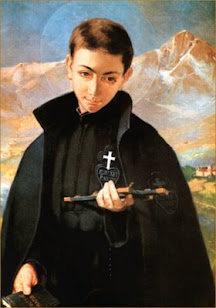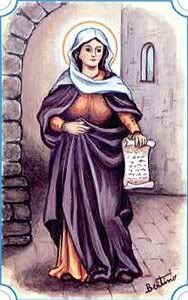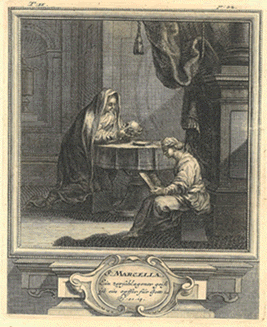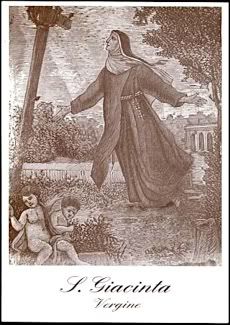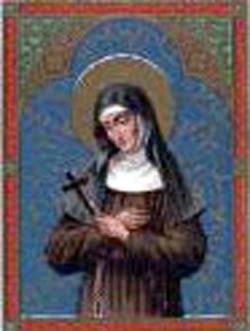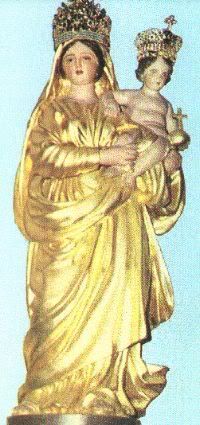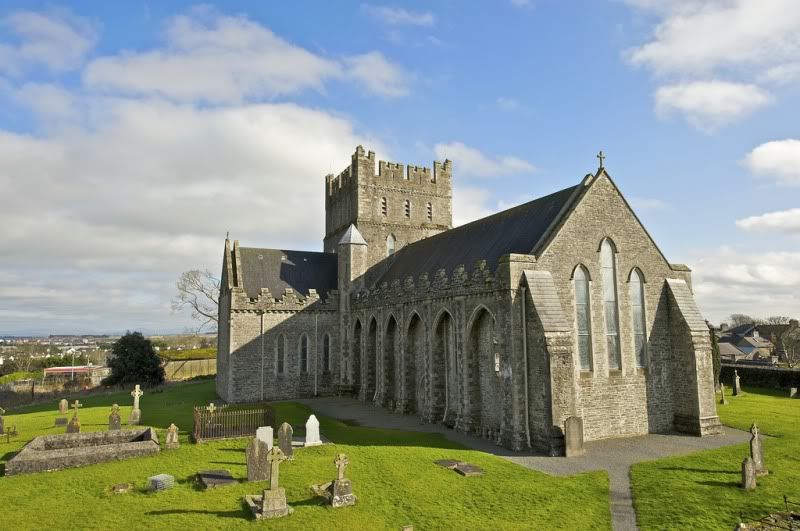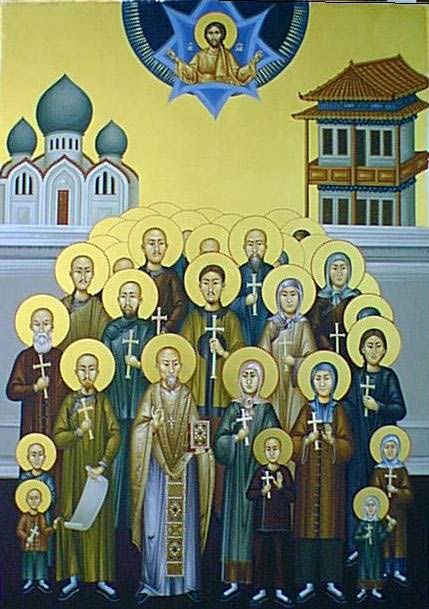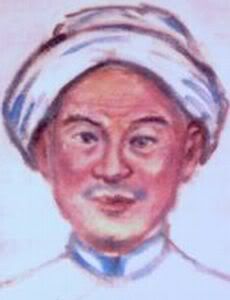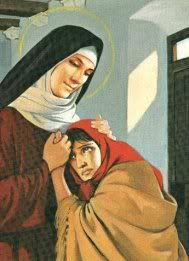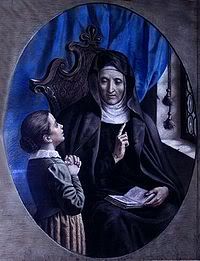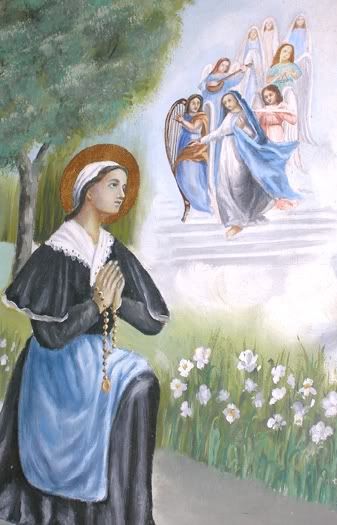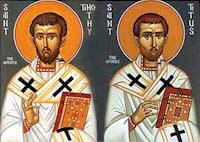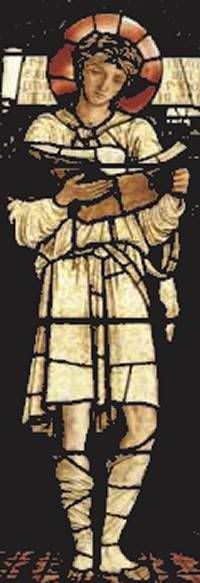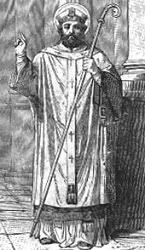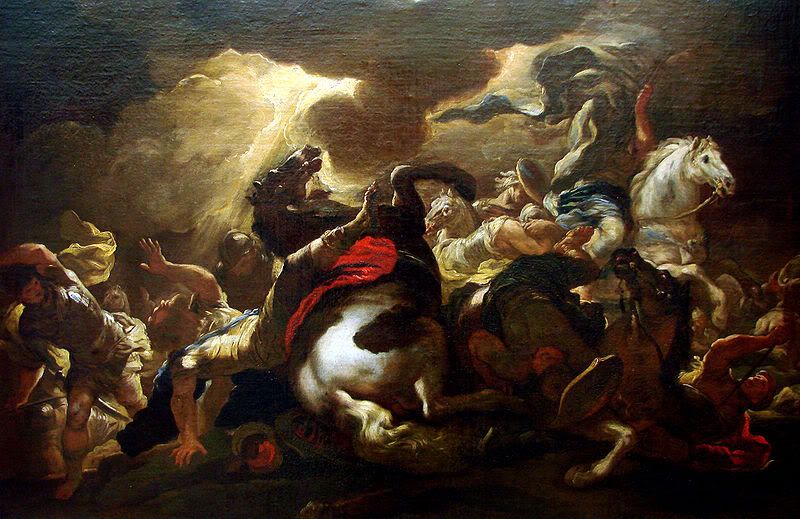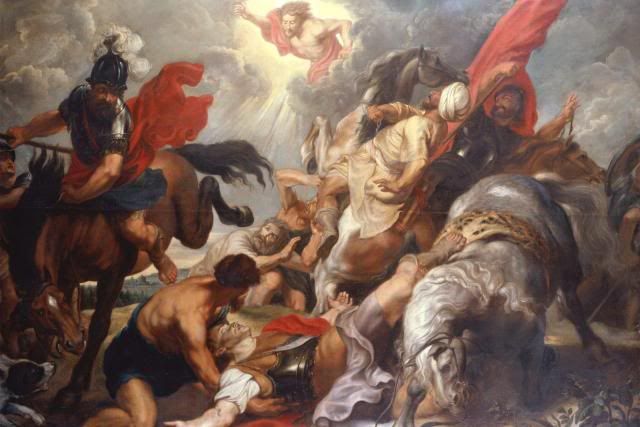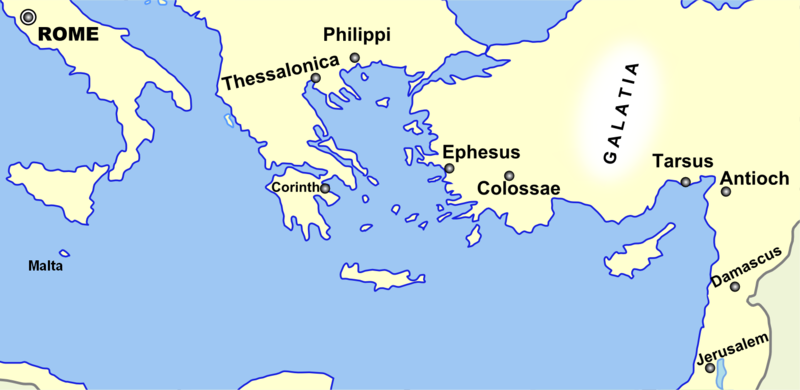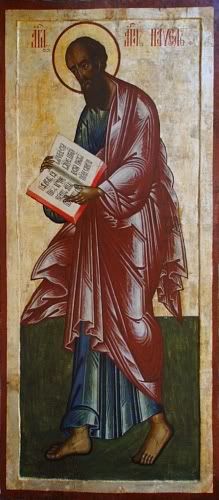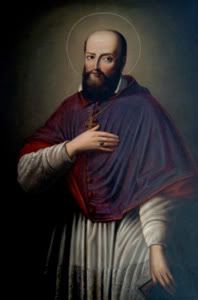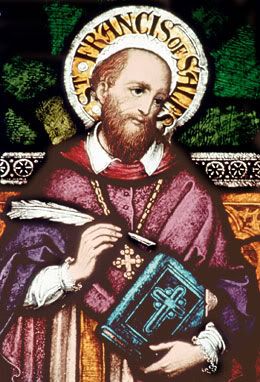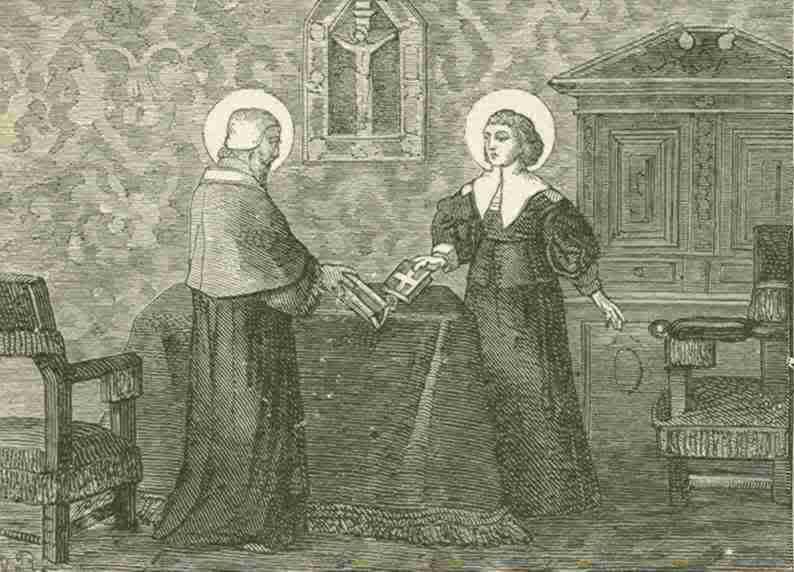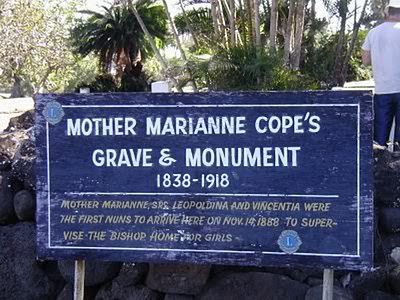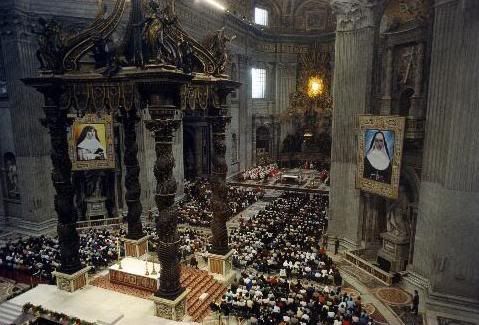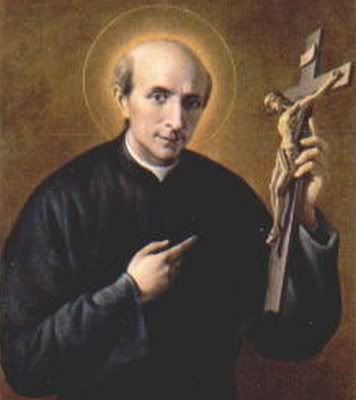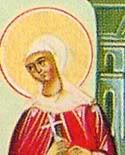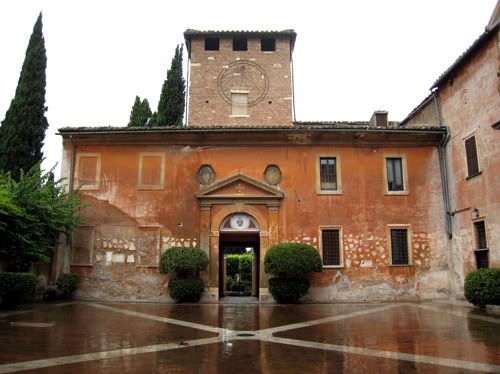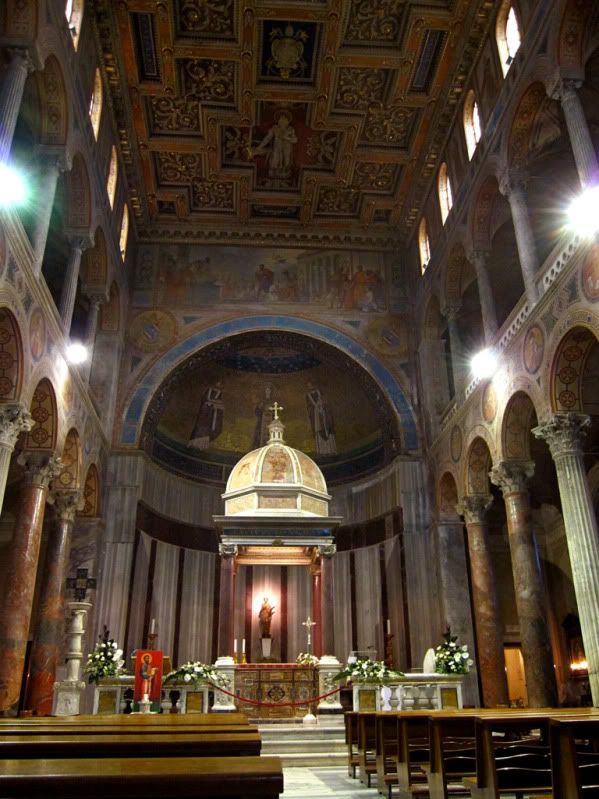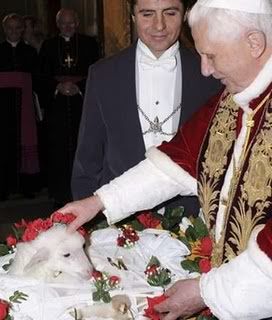Why pray the Rosary every day for a year?
Each time the Blessed Virgin has appeared-- whether it be to Saint Bernadette Soubirous at Lourdes; to Lucia, Jacinta, and Francisco at Fatima; or to Mariette Beco at Banneux-- she has asserted the importance, saving grace, and power of praying the Holy Rosary on a daily basis. Based upon her words, the Rosary is penance and conversion for sinners, a pathway to peace, an end to war, and a powerful act of faith in Jesus Christ. Pope Paul VI presented the Rosary as a powerful means to reach Christ "not merely with Mary but indeed, insofar as this is possible to us, in the same way as Mary, who is certainly the one who thought about Him more than anyone else has ever done."
To show us how this is done, perhaps no one has been more eloquent than the great Cardinal Newman, who wrote: "The great power of the Rosary consists in the fact that it translates the Creed into Prayer. Of course, the Creed is already in a certain sense a prayer and a great act of homage towards God, but the Rosary brings us to meditate again on the great truth of His life and death, and brings this truth close to our hearts. Even Christians, although they know God, usually fear rather than love Him. The strength of the Rosary lies in the particular manner in which it considers these mysteries, since all our thinking about Christ is intertwined with the thought of His Mother, in the relations between Mother and Son; the Holy Family is presented to us, the home in which God lived His infinite love."
As Mary said at Fatima, "Jesus wants to use you to make Me known and loved. He wishes to establish the devotion to My Immaculate Heart throughout the world. I promise salvation to whoever embraces it; these souls will be dear to God, like flowers put by Me to adorn his throne."

Yesterday, I had the pleasure of hosting a small Rosary-contruction gathering. Seven friends gave up the greater part of their Saturday to construct Holy Rosaries to be sent to overseas missionaries and American troops deployed abroad. With the Rosaries lovingly created yesterday, along with those that I have been building each morning, I am happy to report that the total constructed is rapidly approaching 100 (a portion are pictured below)! Please keep my Rosary-construction project in your prayers.
As always, God bless each of you, and may Our Blessed Mother, advocate for all mankind, lift your prayers to the Heart of Jesus.
As a child, Marcella had met Saint Athanasius, and remembered his stories of the Egyptian ascetics (those who practiced rigorous self-discipline and abstinence from worldly pleasures so as to better contemplate the holiness of the Lord). Following the death of her husband, Marcella refused the marriage proposal of a wealthy and powerful man of government, and instead turned herself to works of charity and service to the poor of Rome. She distributed her considerable wealth, “preferring to store her money in the stomachs of the needy rather than hide it in a purse.” Her palace on the Aventine Hill became a center of Christian fellowship and activism. She formed a community of women, mostly of nobility, who gave up their material wealth and possessions to live a life of asceticism and austerity. Marcella abstained from wine and meat; spent her time in pious reading, prayer, and visiting the churches of the apostles and martyrs; and never spoke with any man alone.
Marcella welcomed Saint Jerome upon his arrival in Rome, and he remained with her for three years guiding this monastery and school for devout, aristocratic ladies in the study of the scriptures, prayer, and almsgiving. Marcella was a woman of intellectual ability, and not afraid to confront the masterful Jerome. After his departure from Rome, Marcella corresponded often with her spiritual director, who answered her questions about spiritual matters and referred to her as "the glory of Roman ladies." Eleven of his letters to Marcella survive, in which her tortured life is compared to the sufferings of the poor souls in hell. Marcella wrote in a letter to Saint Jerome: "My sweetest Lord, only remember that I am a poor creature of Thine! For do with me what pleases Thee, now and through eternity! I abandon myself into Thy hands, and am ready to suffer these torments as long as it shall please Thee."
When the Visagoths, led by the barbarian Alaric, besieged and looted Rome in 410, Marcella and the rest of the city were starving. Eighty-five years old at the time, she wrote: “By heaven’s grace, captivity has found me a poor woman, not made me one. Now, I shall go in want of daily bread, but I shall not feel hunger since I am full of Christ.” Marcella was captured soon thereafter. She was tortured and scourged, as her tormentors tried to force her to reveal the location of her hidden wealth. They did not believe her claims to have given it away to the poor. Marcella withstood her own scourging but begged them to spare the others in her community from such treatment. She was released, but died shortly thereafter from the injuries she sustained.
Saint Marcella lived a long life, especially long for that time. When her marriage ended, she turned to the Lord, committing herself wholeheartedly and sincerely to His will. As Christ instructed, she gave up all she had to the poor, inspiring many others to do the same. She deprived herself of worldly pleasures, seeking instead, through prayer and Scripture, to grow closer to Christ. She ministered to those around her, working tirelessly, even at her advanced age. And she joined her suffering to Christ, first in life, than in torture, and eventually in death. Saint Marcella is another example, like Saint Hyacintha, of the power of the Lord’s call, and the possibility and potential for daily conversion in each of us. What is the Lord asking you to do today? And more importantly, will you answer His call?
Day 31 of 365
Prayer Intentions: Conversion and commitment to the Lord through service to others
Requested Intentions: The rest and repose of a dearly departed friend (J); Reconciliation of struggling marriages (A); Reconciliation and healing in personal relationships (N); Safety for friend deployed to Afghanistan (S); Safety of friend/ relief worker in Haiti (L); Health and safety of new daughter (J); Renewal of loving Christ-centered relationship (A).
Special Intentions: Novena to Our Lady of Prompt Succor, for those who are struggling in the face of personal trials and tribulations, unemployment and financial stress, natural disasters (including the poor of Haiti), poverty, war, and exploitation. May Our Lady of Prompt Succor hasten to help us!
At age 17, Hyacintha suffered an unknown accident, and her life was miraculously saved. Not even this changed her heart. At age 20, Hyacintha was passed over by the man she had hopes to marry—he chose her younger sister, which filled her with rage. Furious, she became unable to be tolerated by her parents, who, according to tradition at that time, declared she should enter the convent. Hyacintha half-heartedly took the veil at the Franciscan convent of Viterbo. The Franciscan sisters followed the rules of poverty, chastity, and obedience. While Hyacintha attended devotions, and maintained her vow of chastity, she ignored the rules of poverty and obedience, declaring her intention to use her personal funds to finance a life of comfort. For over 10 years she lived within the convent, maintaining her own kitchen, wearing a habit of the finest material, entertaining visitors, and keeping her room both comfortable and worldly.
It was not until her confessor visited her in her cell to deliver the Holy Eucharist while Hyacintha was ill that her ways changed. Surprised, appalled, and somewhat dismayed, he pointed out the inappropriateness of her life. He stated that her presence in the convent was merely to help the Devil. His remarks changed her heart. She later declared publicly before her sisters and the Franciscan community the errors of her ways, confessing, and becoming a model Franciscan, and mentor to the novices.
Moved by her realization, and changed by the grace of God, Hyacintha discarded her costly habit for an old, used one. She gave up her worldly pleasures, oftentimes going barefoot, replacing her bed with rough boards, rigorously practicing self-denial, and frequently fasting on bread and water for days at a time. Hyacintha requested and performed the most menial jobs in the convent. Her personal devotion to the Jesus, to the Passion of Christ, to the Holy Eucharist, and to the Blessed Mother deepened through contemplative prayer. She embraced mortification, scourging herself with a spiked belt (pictured below), and connecting her bodily pain to the Passion of Christ.
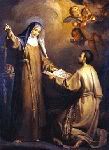 Hyacintha became a model of charity towards others, begging door to door to collect food and clothing for the poorest of her community. She ministered to those others had forgotten: those infected with plague, the homeless, the imprisoned, the ill, and the proud. Hyacintha founded two community groups (one of which, the Oblates of Mary, was dedicated to the Blessed Mother) to serve the poor, ill, and aged. Despite her courage, Hyacintha refused praise or commendation of any kind, considering herself completely unworthy. She said, “The sort of people who most appeal to me are those who are despised, who are devoid of self love and who have little sensible (spiritual) consolation.... The cross, to suffer, to persevere bravely in spite of the lack of all sweetness and relish in prayer: This is the true sign of the spirit of God.”
Hyacintha became a model of charity towards others, begging door to door to collect food and clothing for the poorest of her community. She ministered to those others had forgotten: those infected with plague, the homeless, the imprisoned, the ill, and the proud. Hyacintha founded two community groups (one of which, the Oblates of Mary, was dedicated to the Blessed Mother) to serve the poor, ill, and aged. Despite her courage, Hyacintha refused praise or commendation of any kind, considering herself completely unworthy. She said, “The sort of people who most appeal to me are those who are despised, who are devoid of self love and who have little sensible (spiritual) consolation.... The cross, to suffer, to persevere bravely in spite of the lack of all sweetness and relish in prayer: This is the true sign of the spirit of God.” Saint Hyacintha’s life is unlike many of the holy men and women we hear about. She was blind to the call of the Lord for the first 35 years of her life, choosing instead worldly indulgences. Her repentance and rebirth in Christ, through contemplation, service to those in need, and mortification of her body is all the more remarkable, given her early life. This woman, of quick temper and spiritual apathy, became a model of Christ to her Franciscan sisters and to her community, herself a reflection of His love for all—even those that had been forgotten by society. This inspires us to look at our own lives, regardless of age—what are the habits and addictions we put before the Lord? What worldly pleasures are more important to us than the deepening of our faith in Christ? What will it take for us to hear the call, see the error of our ways, and be reborn?
Day 30 of 365
Prayer Intentions: Courage and conviction to be reborn to the Lord, regardless of age!
Requested Intentions: Reconciliation of struggling marriages (A); Reconciliation and healing in personal relationships (N); Safety for friend deployed to Afghanistan (S); Those considering or having attempted suicide (Pr. L); Those who serve the Archdiocese of Los Angeles (N); Safety of friend/ relief worker in Haiti (L); Health and safety of new daughter (J); Renewal of loving Christ-centered relationship (A).
In 1727, Ursuline nuns founded a monastery in New Orleans, Louisiana, creating an active religious community, schools, and churches. When Louisiana became a Spanish territory in 1763, many sisters arrived from Spain to continue building the growing community of faith. However, these sisters fled in 1800 when New Orleans again became a French territory, and persecution of Catholics (under the reign of Napoleon) again began. Despite this anti-Catholic sentiment, the monastery survived, although the number of sisters quickly dwindled. Mother Saint Andre Madier wrote to a cousin in France, Mother Saint Michel, requesting assistance from her French sisters.
French religious were suffering similar anti-Catholic sentiment, and had found themselves to be short-handed in attending to their communities. Bishop Fournier, who Mother Saint Michel brought her cousin’s request to, denied it, stating that only the Pope could authorize such a request. It should be noted, at that time, Pope Pius VII was imprisoned by Napoleon, and unable to be communicated with. Bishop Fournier’s statement was, therefore, tantamount to absolute refusal. Nonetheless, Mother Saint Michel wrote the Pope, submitting her request to travel to New Orleans with a group of sisters, and aid in the re-invigoration of the new world faith community.
Before sending the letter, Mother Saint Michel prayed: O most Holy Virgin Mary, if you obtain for me a prompt and favorable answer to this letter, I promise to have you honored at New Orleans under the title of Our Lady of Prompt Succor. Her letter was sent on March 19, 1809. Despite the odds, she promptly received a response on April 29, 1809, granting her request. Mother Saint Michel, commissioned a golden statue of Our Lady of Prompt Succor holding the Infant Jesus. Both the Blessed Mother and the infant Christ were sculpted with golden crowns, Jesus holding a globe with a cross affixed to it, and the two Holy Family members looking in different directions as if they each had important tasks to focus on. The statue was blessed by Bishop Fournier, now convinced of the importance of the mission by the miraculous response, and Mother Saint Michel and several postulates departed for New Orleans.
The group arrived in New Orleans on December 31, 1810, and placed the golden statue of Our Lady of Prompt Succor in the monastery chapel. Devotion to the Blessed Mother grew, and within five years, two miracles were attributed to prayers offered before the statue.
In 1812, a terrible fire ravaged the city of New Orleans, destroying large tracts of homes and businesses. Driven by a raging wind, the flames of the great fire moved quickly toward the convent. With all certainly lost, the sisters of the convent were ordered to evacuate. One sister, however, Sister Anthony, placed a small statue of Our Lady of Prompt Succor on a window sill facing the advancing wall of flames, and Mother St. Michel prayed aloud: "Our Lady of Prompt Succor, we are lost, unless you hasten to our help." In an instant, the wind changed and the fire stopped its steady advance. The convent was saved and the flames extinguished. Witnesses claimed: "Our Lady of Prompt Succor has saved us!"
Again, in 1815, the convent, and indeed all of the city, was threatened, this time by British soldiers. On January 8, General Andrew Jackson and less than 1,000 soldiers (by some reports) were engaged in battle by an overwhelming force of British soldiers (more than 15,000). The citizens of New Orleans prayed to Our Lady for safety and success in battle. Along with the Ursuline sisters, the town gathered in the chapel of Our Lady of Prompt Succor, weeping and praying. Mass was offered at the altar on which the statue of Our Lady of Prompt Succor had been placed, and the Ursuline sisters made a vow to have a Mass of Thanksgiving sung annually should the American forces win. At the very moment of Holy Eucharist, word reached the chapel that the American forces had prevailed with miraculously few casualties. The entire battle took less than 25 minutes. Jackson acknowledged the intercession of the Blessed Mother in the victory and visited the chapel to thank the sisters. To this day, on January 8, a Mass of Thanksgiving continues to be offered.
Our Lady of Prompt Succor continues to watch over us, with numerous personal miracles and intercessions reported since the arrival of the statue in New Orleans. Moved from the old monastery in the city’s French Quarter, it now is displayed at the convent’s new chapel where citizens of the city continue to pray for intercession. The statue itself is regarded as the oldest image of the Blessed Mother and the Infant Christ in the United States.
Prayer for Intercession of Our Lady of Prompt Succor
Our Lady of Prompt Succor, ever Virgin Mother of Jesus Christ our Lord and God, you are most powerful against the enemy of our salvation. The divine promise of a Redeemer was announced right after the sin of our first parents; and you, through your Divine Son, crushed the serpent's head. Hasten, then, to our help and deliver us from the deceits of Satan. Intercede for us with Jesus that we may always accept God's graces and be found faithful to Him in our particular states of life. As you once saved the City of New Orleans from ravaging flames and our Country from an invading army, have pity on us and obtain for us protection from hurricanes and all other disasters. (Silent pause for individual petitions.) Assist us in the many trials which beset our path through life. Watch over the Church and the Pope as they uphold with total fidelity the purity of faith and morals against unremitting opposition. Be to us truly Our Lady of Prompt Succor now and especially at the hour of our death, that we may gain everlasting life through the merits of Jesus Christ Who lives and reigns with the Father and the Holy Spirit, one God, world without end. Amen.
Our Lady of Prompt Succor, hasten to help us.
Our Lady of Prompt Succor, hasten to help us.
Our Lady of Prompt Succor, hasten to help us.
Today, I begin a Novena to Our Lady of Prompt Succor, for those who are struggling in the face of personal trials and tribulations, unemployment and financial stress, natural disasters (including the poor of Haiti), poverty, war, and exploitation. May Our Lady of Prompt Succor hasten to help us!
Sometimes our lives seem quite simple and ordinary. In comparing ourselves to the Holy men and women who came before us, saints and martyrs, we may feel as if we fall short, or aren’t accomplishing daily tasks of any great significance. Saint Blath of Kildare demonstrates for us that even the most simple and ordinary tasks of daily life can become extraordinary and sacred when completed with unfailing love and devotion to Christ.
Saint Blath of Kildare (born unknown, deceased 523), also known as Flora (as her name means “flower), was a lay-sister of the Convent of Saint Brigid in Kildare, Ireland. Saint Blath was especially devoted to Saint Brigid, who founded the monastery which would become the center of religious teaching, art, and study.
Saint Blath served as cook for the monastery, the sisters of which having taken a vow of poverty, frequently gave away all their food to the poor. Saint Blath’s simple, personal sanctity, and unending faith in the Lord, is credited for consistently putting just enough food on the table for the sisters—whether it be due to stray dogs showing up at the kitchen door with bacon, the monastery’s cow producing supernatural quantities of milk, or pounds of butter and bread given away miraculously appearing in the larder the next day. It is said that, under the care of St. Blath, that the bread and bacon at St. Brigid's table were better than a banquet anywhere else at the time.
Little else is known about Saint Blath, other than her heart of service and her faith in the Lord to provide. But perhaps these two things are enough! She undertook the most basic of daily tasks—something that most of us do everyday—with devotion to Christ, and in the process created the impossibly extraordinary. We might all take a lesson from this humble servant, turning our faces toward the Lord in the midst of routine, mundane, and everyday tasks. With Him beside us, we can’t predict the extraordinary fruits of our labors!
Day 29 of 365
Prayer Intentions: Never to lose sight of God, even in “ordinary” daily tasks
Requested Intentions: Reconciliation of struggling marriages (A); Reconciliation and healing in personal relationships (N); Safety for friend deployed to Afghanistan (S); Those considering or having attempted suicide (Pr. L); Those who serve the Archdiocese of Los Angeles (N); Safety of friend/ relief worker in Haiti (L); Health and safety of new daughter (J); Renewal of loving Christ-centered relationship (A).
The earliest martyrs of China are recognized in the early 17th century, although Christianity in China is recorded as early as the Tang Dynasty (in the 600s). In the 1600s, however, the Emperor became bothered by the frequent requests of his people for baptism and participation in organized religious rites. Christians were being persecuted in neighboring Japan at the time, and this is also thought to have influenced the first wave of anti-Christian sentiment which resulted.
In 1648, the first martyr of China is recorded. Blessed Francis Fernandez de Capillas, a Franciscan brother and teacher, was beheaded while praying the Holy Rosary and meditating on the Sorrowful Mysteries. Subsequent to his death, persecution increased across the continent, growing in frequency and intensity. Official decrees followed in 1805, 1811, and 1813, ordering persecution against those who were seeking ordination, studying Holy Scripture, and practicing as servants of the Church. Those who voluntarily renounced their faith were saved from harsh punishment. During this time, Saint Jerome Lu and Blessed Lawrence Wang were martyred.
Saint Jerome Lu was born in Mao-Cheu, China where he joined the church at an early age, working as a catechist and teaching the Holy Scriptures to his neighbors. Upon discovery in 1858, he was beheaded in his hometown at Maokou. Blessed Lawrence Wang has a similar story. Born in Kuy-yang, he also served as a catechist in Maokou, and was beheaded with Saint Jerome in 1858. Along with Saint Jerome and Blessed Lawrence, a third catechist was beheaded, Blessed Angela Lin Zao, after failing to renounce Christianity and the Rites of the Catholic Church. They were ordered to be tortured and executed by the Mandarin of Maokou, and likely died (like their predecessors), praying the Holy Rosary together.
Active persecution of Chinese Christians ceased in 1846, during a 50 year period of tenuous peace with foreign traders and pressure from the outside world. However, during the bloody Boxer Rebellion on 1900, newer and harsher edicts were proclaimed against Christians, resulting in the deaths of 86 recognized Catholic martyrs during that year alone. It is estimated that thousands of Christians gave their lives during this uprising for their faith.
Harsh persecution of Christians ceased in 1930, although with the rise of communism in China, few personal liberties to practice Christian faith were permitted. Rather than death, imprisonment became a common punishment for those who failed to renounce their faith. In recent decades, this has improved, with organized (state-monitored) religious gatherings allowed.
The road for Christians in China, and many other countries, has been long, difficult, and oftentimes dangerous. These courageous men and women of faith have clung tightly to the Gospel, finding their peace in Christ in the most difficult of times, and never losing site of the promise of redemption and personal resurrection. These “new” martyrs of China endured dangers and persecution, declaring their belief in Christ, and their extravagant love for the Lord. As Saint Thomas Aquinas (whose feast we also celebrate today) tells us, “The things that we love tell us what we are.” This begs the questions: What are we? What do we love? and How do we show that love to the world?
Day 28 of 365
Prayer Intentions: Courage and Faith
Requested Intentions: Reconciliation of struggling marriages (A); Reconciliation and healing in personal relationships (N); Safety for friend deployed to Afghanistan (S); Those considering or having attempted suicide (Pr. L); Those who serve the Archdiocese of Los Angeles (N); Safety of friend/ relief worker in Haiti (L); Health and safety of new daughter (J); Renewal of loving Christ-centered relationship (A).
In a time where there is much debate about Church reform, we might look to the wisdom of Saint Angela Merici. During particularly challenging times, when the “new way” of service was struggling, Saint Angela would tell her sisters, “If according to times and needs you should be obliged to make fresh rules and change certain things, do it with prudence and good advice.” Perseverance, love, and adherence to the laws of God were to guide decisions and shape our lives.
Angela was born to an Italian farming family, the older of two sisters, both of who quickly learned the virtue of hard work. Angela felt called to the Holy life at an early age, despite receiving formal religious education, committing herself to daily prayer and song. As she aged, she wanted to emulate Saint Francis, and live in austerity, forgoing even sleeping in a bed. Instead, she slept on the floor so that her body might not be too comfortable, and her heart could remain focused on the Lord. Prior to age 10, Angela took a vow of chastity, declaring her intentions to remain a virgin for the Lord.
Following her parents’ deaths, Angela and her sister were sent to live with a wealthy uncle. Shortly afterwards, Angela’s sister died unexpectedly, before she was able to receive the sacrament of Last Rites. Angela herself had yet to receive Holy Communion, due to both her lack of education, her gender, and the delays common in that time period. Extremely upset by her sister’s death, Angela’s eyes were opened to the plight of young girls around her. Few received education, and even fewer, religious education of any kind. Angela saw, even in her youth, that this lack of education was detrimental to families, as there were few “Christian mothers” who could instruct their children in the ways of the Lord.
Angela prayed about her revelation, as well as the condition of her sister’s soul. Through her dedication and concern for her sister, Angela was rewarded with a vision one afternoon while farming in the fields. She saw her sister, surrounded by angels and young girls, smiling and at peace. Angela interpreted this vision as a call from the Lord to do something about the state of religious education for women. She “invented” the new way, and formed a company of sisters under the patronage of Saint Ursula.
The Ursuline company was novel for its day. At a time where women remained cloistered in prayer, Angela and her slowly growing group of women remained in the community, living with families. They identified poor young girls and women, instructing them in prayer and religion. They collected alms by which to live, but generally distributed all but bare necessity to the poor of the region. Not a recognized or organized sect, Angela nonetheless instructed her sisters in Christian doctrine, which they in turn passed to those they served. Vows of chastity, poverty, and obedience were expected. Despite her lack of “formal” education, Angela was regarded as clear-headed, Christ-centered, and pious, and was often visited by priests and theologians for consultation.
It was not until 1535, five years before her death, and after a trip to the Holy Land where she was struck blind, that Angela officially founded the new order of Ursulines with approval from the pope. The order, still in existence, continues to share the early mission of Saint Angela, serving those in need and focusing on Christian education and social justice. Ursuline sisters may be found throughout the world, and have founded schools for secondary education, as well as universities and colleges.
Today, given her tireless work to serve the poor, and her refusal to accept the rules and stereotypes of the times, Saint Angela Merici is considered the patron saint against sickness and bodily ills, disability, and the loss of parents. She is the patroness of orphans, the disabled, and the mentally challenged.
Saint Angela Merici saw the world simply, first as a child, and then later as an adult and leader in her community. Rather than turn a blind eye toward the social injustices around her, she embraced those in need with her heart, her prayers, and her service. Not to be deterred by expectations and perceived limitations, Angela listened attentively to God’s call, and then, against the odds, worked tirelessly to literally change the world. What could we be doing to help those around us? What limits do we place on ourselves due to what we perceive to be societal restrictions, role expectations, or prohibitions by those we come in contact with? Even a glimpse at Saint Angela’s life inspires us to view the world through the eyes of a child, identify what needs to improve, and then find a “new way” to change the world.
O Lord, let St. Angela never cease commending us to Your kindness. By always imitating her charity and prudence may we succeed in keeping Your teachings and reflecting them in our lives. Amen.
Day 27of 365
Prayer Intentions: Charity and Prudence; Courage to work for social justice; Those suffering in the aftermath of the Haitian earthquake
Requested Intentions: Reconciliation of struggling marriages (A); Friend beginning new job of ministry (J); Reconciliation and Healing in personal relationships (N); Safety for friend deployed to Afghanistan (S); Those considering or having attempted suicide (Pr. L); Those who serve the Archdiocese of Los Angeles (N); Safety of friend/ relief worker in Haiti (L); Health and safety of new daughter (J); Renewal of loving Christ-centered relationship (A).
So, I am almost one month into this incredible spiritual journey of a year of prayer. Already, I have gained so much from those who I have talked to about this project, those who have submitted comments and prayer requests, and the prayers and intentions of all who had prayed for the success of this endeavor. I am overcome with gladness at the response that this humble blog has recieved, and find my emotions difficult to put into words (surprisingly!).
So, instead, a few "statistics":
In the last 25 days, there have been over 300 visitors to the site (thank you!). Those who have dropped by to read and reflect have lived in 10 different countries (on 5 continents)! Over 50 readers have submitted personal prayer intentions, which I have been both humbled and privilieged to have the opportunity to lift in prayer. (Please continue to share this site with those you come into contact with!) I'm busy constructing Rosaries, and this week marks the first group Rosary-construction gathering, which I hope to continue over the course of the year. Funded by the grace of God and your donations, I hope to send hundreds (or even a thousand!) Rosaries overseas to missionaries and deployed soldiers in need of spiritual assistance. (It's not too late to donate-- simply visit the donate button on the lefthand sidebar!).
All in all, this is more than I could have expected. I humbly thank God for all He has given, Our Blessed Mother for her continual intercessions on the behalf of a sinful man, and all of you for continuing to visit the site. God bless you all in 2010! Together, we can change the world!
Saint Timothy (birth unknown, deceased 97 AD) was born in Lystra, Lycaenia, the son of a Greek father and Jewish mother. As a child, he spent considerable time studying the Holy Scriptures, devoting himself to the Holy Spirit. Upon Saint Paul’s first visit to Lycaenia, Timothy was just a child, but his mother and grandmother, whose faith Paul commends, converted to Christianity. Upon Paul’s second return, approximately seven years later, Timothy, now a young man, followed him, becoming a discipline, confidant, and friend.
Saint Timothy traveled throughout the Mediterranean and Asia (Phrygia, Galatia and Mysia, Troas, Philippi, Veria, Thessolonica, and Corinth) with Saint Paul, oftentimes the discipline sent ahead to prepare a city, or left behind to guide a new church. Timothy, known for a gentle disposition was the discipline whom Paul relied upon to smooth out hard feelings and restore faith in angered Jewish communities, such as Berea (which Paul was expelled from). Timothy was imprisoned with Paul in Caesarea and then Rome, but later freed while Paul remained. Saint Paul wrote two letters to Timothy, regarding him as his “own son in faith,” one from Macedonia and the second from his Roman prison.
Timothy, regarded as tender and affectionate, lived a life of sacrifice and austerity. We know that he drank only water, likely as penance, and was frequently sick with stomach complaints and ailments. While he may have been timid in life, Timothy was a Christian force of virtue, gentle, humble, and committed to the teachings of Christ. His demeanor won him the hearts of the most difficult communities, leading to successful conversion. He was made bishop of Ephesus, where he was stoned to death, martyred for opposing the pagan festival of Katagogian in honor of Diana.
Like Saint Timothy, Saint Titus (birth unknown, death 94 AD) was a close friend of Saint Paul, and accompanied him on many of his missionary works throughout the Mediterranean and Asia (Ephesus, Corinth, Macedonia, Crete, Dalmatia). Unlike, Saint Timothy, Titus was known as a firm and somewhat fear-inspiring disciple of Paul, sent not to smooth over difficulties, but deliver difficult news and inspire faith and repentance.
Saint Titus is viewed as a great administrator of the early Church, responsible for correcting abuses, encouraging alms-giving, and modeling discretion and correction of scandal. Saint Titus was dispatched by Paul to Corinth (where he was received with “fear and trembling”), to increase the charity of the community, while cementing their faith. This he did with zeal, firmly re-establishing the Church in Corinth prior to Paul’s return. Firm though he was, Titus was also patient, and the first among any group to point out the goodness in others, even when it was hidden.
Little is known about the death of Saint Titus. Installed as bishop on the island of Crete, he died of apparent natural causes, rare in that time for Christian missionaries! His remains are buried at Saint Mark’s Cathedral in Venice.
We look to the lives of two very different men today, Saints Timothy and Titus, and their dedication and zeal for the word of God. Each used the gifts that were provided to them by the Lord to spread the truth of the Gospel—one with humility, affection, and a gentle spirit, the other with firmness, sympathy, charity, and respect. Both were united in their love of Christ, and their friendship with Saint Paul. It is the friendship, which Paul writes about in his Epistles to both Timothy and Titus, that sustains and brings comfort during the difficult times of travel, separation, persecution, and imprisonment. Who are our own brothers and sisters and “sons in faith?” Who do we rely on to offer us not only support, but accountability in Christ? We pause today to pray for those in our lives who help keep us on the right path, looking to Saints Paul, Timothy, and Titus as a model of Christian love and friendship.
Day 26 of 365
Prayer Intentions: Strengthening of Christian friendship and accountability; Those suffering in the aftermath of the Haitian earthquake
Requested Intentions: Reconciliation and Healing in personal relationships (N); Safety for friend deployed to Afghanistan (S); Those considering or having attempted suicide (Pr. L); Those who serve the Archdiocese of Los Angeles (N); Safety of friend/ relief worker in Haiti (L); Health and safety of new daughter (J); Renewal of loving Christ-centered relationship (A).
Born in Tarsus to a noble family, Saint Paul was at first named Saul. His family, given the laws at the time, were bestowed the rights and privileges of citizens of the Roman Empire. Saul grew up instructed in Mosaic Law, which he strictly observed. Sent to Jerusalem to study, Saul mentored with the strictest and most prideful sect of Pharisees. As was the Jewish rule of the time, he also learned the craft of tent-making. During this time (36 A.D.), Christianity was spreading throughout the region, but was not to be tolerated.
Saint Stephen the Deacon was an early martyr of the church at that time. He was persecuted and put on trial by the Sanhedrin for preaching the message of Christ. Throughout his trial, he remained steadfast in his faith, with “the countenance of an angel.” Eventually, the observers, acting “as a single man,” rushed at him, dragged him from the city, and stoned him to death. While they were doing so, they laid their cloaks at the feet of Saul, who kept them—a sign at the times for responsibility of the execution. While he was dying, Saint Stephen pleaded for the forgiveness of his tormentors, including Saul. 60 He fell to his knees and cried out in a loud voice, “Lord do not hold this sin against them.” And with that he died. (Acts of the Apostles, 7:60) Saints and theologians credit Saint Stephen’s intercession as one of the precursors to the Lord’s conversion of Saul.
1 Saul, for his part, concurred in the act of killing. That day saw the beginning of a great persecution of the church in Jerusalem. (Acts of the Apostles, 8:1) By virtue of the power he had received from the high priest, Saul dragged Christians out of their homes, loaded them with chains, and thrust them into prison where they were tortured and oftentimes executed. He was ruthless and unmoved by their pleas for mercy. In the fury of his zeal he asked for permission to persecute all the Jews in Damascus who confessed to Jesus Christ, and to bring them in bonds to Jerusalem, that they might serve as examples for the others. It was with this permission that Saul, and his assistants, set off on the road to Damascus, where he would encounter the saving grace, and unquestionable patience and mercy of the Lord.
1 Saul, still breathing murderous threats against the Lord’s disciples, went to the high priest 2 and asked him for letters to the synagogues in Damascus which would empower him to arrest and bring to Jerusalem anyone he might find, man or woman, living according to the new way. 3 As he traveled along and was approaching Damascus, a light form the sky suddenly flashed about him. 4 He fell to the ground and at the same time heard a voice saying, “Saul, Saul, why do you persecute me?” 5 “Who are you, sir?” he asked. The voice answered, “I am Jesus, the one you are persecuting. 6 Get up and go into the city, where you will be told what to do.” (Acts of the Apostles, 9:1-6)
In his epistles, Paul details that while he was struck down and blinded, he experienced a vision of Jesus. But he further explains that vision does not fully capture the experience. Rather, an “illumination” of his life, and above all, a “revelation” of the vocation that will become his calling. He preaches throughout the world the mysteries of Christ, and the simple truth that conversion was not the result of a development of thought or reflection, but the fruit of divine intervention-- an unforeseeable, divine grace. Paul’s message is clear: Jesus Christ must remain the center of our lives, so that our identity is tied to his, just as Paul’s identity was reborn through his encounter with Christ. Our lives are made whole through the Eucharist, by communion with Christ, and in his Word which restores purity and virtue.
Saint Paul went on to preach throughout the Mediterranean. He authored thirteen epistles of the New Testament, spreading the word of God, and greatly contributing to the growth of the Church. The blasphemer and persecutor had become the greatest writer of that time.
Upon returning to Jerusalem (approximately 60 AD), Saint Paul was beheaded, a Christian martyr. His remains are buried at the Basilica of Saint Paul, outside the walls of Rome. Recent scientific inquiry into the remains, at the behest of Pope Benedict XVI, has confirmed their authenticity.
Pope Benedict XVI, in a general audience, spoke of Saint Paul, saying, “Clement of Rome, my Predecessor to this Apostolic See, wrote of [Paul of Tarsus] in the last years of the first century: ‘Because of jealousy and discord, Paul was obliged to show us how one obtains the prize of patience.... After preaching justice to all in the world, and after having arrived at the limits of the West, he endured martyrdom before the political rulers; in this way he left this world and reached the holy place, thus becoming the greatest model of perseverance.’”
Saint Paul was a tireless preacher of the truth of Christ’s love, his letter beautiful and elegant instruction in the salvation of the Lord. But he is the same man, Saul, who ceaselessly persecuted Christians, prior to his meeting Jesus on the road to Damascus. In considering that meeting, we are struck by his amazing conversion, his rebirth into life through the love and saving grace of Christ. No longer was redemption bound by the law, or acquired through works, but instead, assured through commitment to Christ and his loving forgiveness. We are left with the certainty that if the Lord can enable Saul to start anew as Saint Paul, He will change us for the better if we believe whole-heartedly and with conviction. Called to conversion on a daily basis, today we pause to examine what we could do better, and ask our Lord to change our hearts.
38 For I am certain that neither death nor life, neither angels nor principalities, neither the present nor the future, nor powers, 39 neither height nor depth nor any other creature, will be able to separate us from the love of God that comes to us in Jesus Christ, our Lord. (Romans 8:38-39)
Day 25 of 365
Prayer Intentions: True Conversion; Those suffering in the aftermath of the Haitian earthquake
Requested Intentions: Safety for friend deployed to Afghanistan (S); Those considering or having attempted suicide (Pr. L); Those who serve the Archdiocese of Los Angeles (N); Safety of friend/ relief worker in Haiti (L); Health and safety of new daughter (J); Renewal of loving Christ-centered relationship (A).
Born into a noble family in France, and expected to become a solider or lawyer, Saint Francis felt called to the priesthood at a young age. However, in a pattern that would repeat throughout his life, he waited thirteen years to be certain of his calling. During that time, he traveled, attended university, and earned a doctorate in law. Possessing a quick temper, by his own report, Francis dedicated himself to studies of theology, mental discipline, and prayer during his time at university. Tradition holds that despite encouragement from local priests and bishops, as well as teachers, Saint Francis was not convinced that the Lord was calling him to the priesthood until a series of falls while out riding his horse one afternoon. During his ride, Francis was thrown three times from his horse. Each time, his sword fell from its scabbard, landing as a cross. Upon his third viewing of the cross, Saint Francis returned home to seek parental permission to join the priesthood.
Saint Francis was ordained during the time of the Calvinist Reformation. Just over the mountains from his home in France lay a community of approximately 60,000 Catholics who had renounced the Church, becoming Calvinists. Francis felt moved to venture into the Swiss community and reclaim the converts. Unable to find anyone to accompany him, he embarked alone, on foot, traveling through rough, cold, and snowy country. He visited families in the wilderness, knocking on doors, oftentimes treated poorly. Despite rejection and years of work without moving a single soul, Saint Francis never gave up. He painstakingly wrote sermons and homilies out by hand, slipping them under doors, becoming one of the first to do so (and becoming the patron saint of journalists in the process). He slept outside, or in haylofts if possible, oftentimes freezing. His feet, from being constantly cold and wet, became infected and bled. Yet, he did not give up. When parents would refuse to speak with him, he would play instead, with their children. Observing his gentle disposition, patience, and conviction, the parents would oftentimes come around and entertain a conversation. Over the course of several years, Saint Francis’ patience and steadfast determination brought over 40,000 back to the Church. He was appointed Bishop of Geneva.
It was during this time in his life that he met a widow, whom he had observed during Mass, paying close attention to his sermons. Jane Frances de Chantal became a friend, and later asked Francis to become her confessor. Again, Francis hesitated, praying, and waiting to determine if this was the will of God. During that time, a man approached Francis three times regarding his thoughts of donating a building to be used as a holy place for women. As typical, Saint Francis listened, but did not push the man. On his third visit, the man donated a building, which would become the convent of the sisters of the Order of the Visitation of Holy Mary.
Jane Frances de Chantal, herself a saint, offered herself to Mary, Mother of God, as a young orphan, assuring herself of the Blessed Mother’s protection throughout a difficult life. Following marriage to a wealthy noble, Jane Frances experienced significant difficulty and loss, including the death of two children and her sister, and the eventual murder of her husband by a friend. Following these losses, Saint Jane Frances endured financial struggles, and was repeatedly taken advantage of by friends, servants, and acquaintances. Never losing faith, Jane Frances left her home, determined to live a life for God alone. With Saint Francis, she founded a great order—the Order of the Visitation of Holy Mary—a holy order for young and old women alike, dedicated to the Heart of Jesus, and committed to the Christian traits demonstrated by Elizabeth during her visitation with the Blessed Mother. The special charism of the Visitation Order combines gentleness with a valiant spirit. Both apostolic and contemplative, sisters of the order balance a dedication to prayer with a serving presence in the world. Eighty-seven houses of the Visitation were built in nine years during the time of Saint Jane Frances. Today, the Order numbers approximately 3,000 sisters, with presence in 168 monasteries throughout the world. At age 70, Saint Jane Frances de Chantal died peacefully. St. Vincent de Paul reported seeing, at the moment of her death, her soul ascend, as a ball of fire, to heaven. Her feast day is celebrated on August 21.
Saint Francis de Sales went on to write many works on the Catholic faith, oftentimes copying them by hand for distribution to the faithful. He further spent hours each day answering letters by hand, providing spiritual direction and catechetical instruction. As bishop, he tirelessly preached, reaching out to the poor. He instituted guidelines for clergy, and became one of the first to offer organized catechetical instruction to the young and old alike. His written works, including “An Introduction to the Devout Life” and “Treatise on the Love of God” are still regarded by the Church as “a bright light… pointing out to souls an easy and safe way to arrive at the perfection of a Christian life" (Breviarium Romanum, 29 January, lecture VI).
In 1622, Saint Francis traveled to France, where he was to die at the age of 56. His remains (with the exception of his heart, which was left in Lyons) were returned to the Convent of the Visitation of Holy Mary in Annecy, where numerous miracles have been reported by his tomb. During the French Revolution, his heart was carried by the Visitation nuns from Lyons to Venice, where it is still venerated today
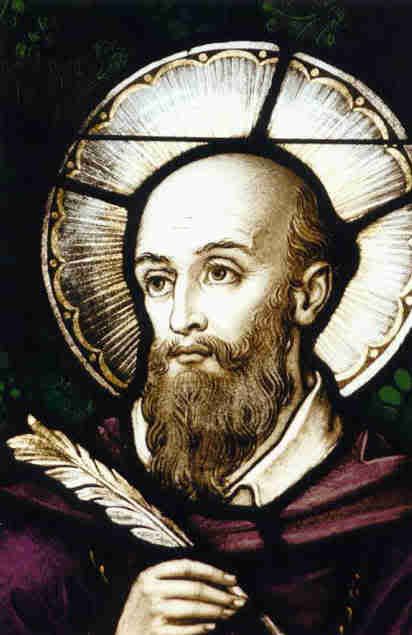 Saint Francis lived an austere and simple life, minimizing his possessions so as to better focus on the will of the Lord. His writings reinforce the two elements of a spiritual life: love and penance, with love being primary. He taught that penance should be practiced from a place of love for Christ, a motive of simple, gentle, and generous fidelity to the will of God. He wrote, of exemplifying Christ in our lives, "You will study His countenance, and perform your actions as He did." For Saint Francis, the key to love of God was prayer. He wrote, "By turning your eyes on God in meditation, your whole soul will be filled with God. Begin all your prayers in the presence of God." But prayer was not enough. The truth of prayer was reflected in a person's actions: "To be an angel in prayer and a beast in one's relations with people is to go lame on both legs."
Saint Francis lived an austere and simple life, minimizing his possessions so as to better focus on the will of the Lord. His writings reinforce the two elements of a spiritual life: love and penance, with love being primary. He taught that penance should be practiced from a place of love for Christ, a motive of simple, gentle, and generous fidelity to the will of God. He wrote, of exemplifying Christ in our lives, "You will study His countenance, and perform your actions as He did." For Saint Francis, the key to love of God was prayer. He wrote, "By turning your eyes on God in meditation, your whole soul will be filled with God. Begin all your prayers in the presence of God." But prayer was not enough. The truth of prayer was reflected in a person's actions: "To be an angel in prayer and a beast in one's relations with people is to go lame on both legs."Day 24 of 365
Prayer Intentions: Humility, Patience, Forgiveness of others, and Love; Those suffering in the aftermath of the Haitian earthquake
Requested Intentions: Those considering or having attempted suicide (Pr. L); Those who serve the Archdiocese of Los Angeles (N); Safety of friend/ relief worker in Haiti (L); Health and safety of new daughter (J); Renewal of loving Christ-centered relationship (A).
After a series of teaching positions, that eventually led to mostly administrative positions, Marianne found herself working in healthcare. She successfully served as administrator of several small clinics and hospitals, and became known for treating patients who most facilities turned away. She looked with kindness on the “outcasts” of society, including alcoholics and drug users, and others the world had written off. As news of her caring heart and practical mind (despite never attending school past the eighth grade) spread, she received a life-changing offer from a Catholic priest in Moloka’i, Hawai’i. He asked Marianne for help running a small community for lepers. She responded enthusiastically, writing, “I am hungry for the work and I wish with all my heart to be one of the chosen Ones, whose privilege it will be, to sacrifice themselves for the salvation of the souls of the poor Islanders... I am not afraid of any disease, hence it would be my greatest delight even to minister to the abandoned ‘lepers.’” Marianne and six sisters from her order travelled to Hawai’i, where she would spend the next thirty years tirelessly working to aid those in need.
In 1888, Mother Marianne moved to Kalaupapa, a leper isolation community established by Hawaiian King Kamehaha V, and ministered to by Blessed Father Damien. She undertook administration of that colony upon his death, working to “bring joy” into the lives of the ill. She miraculously remained healthy throughout her service, known for unflinching courage, and a cheerful disposition. For Mother Marianne, looking upon the faces of her people, outcasts though they might be, was like “looking upon the face of Christ.”
The innocent sufferers smiling at the rod,
A fool were tempted to deny his God.
He sees, and shrinks; but if he look again,
Lo, beauty springing from the breast of pain!—
He marks the sisters on the painful shores,
And even a fool is silent and adores.
Mother Marianne was venerated by Pope John Paul II in April 2004, following reports by the faithful of miraculous cures at her intercession. She was beatified by Pope benedict XVI in May 2005. Her feast day is celebrated on January 23, her date of birth.
Mother Marianne, like Saint Vincent Pallotti, saw the need of radical service in the world. Looking to Christ as a model, Blessed Mother Marriane gave up her own life in service to others, isolating herself with those in need, and becoming “outcast” with them. Her courage, love, and kindness inspire us to evaluate our communities, our world, and see where our gifts of service may be needed. How can we improve the lives of others? Remebering that all are equal in God’s love, and that no sheep is misplaced or forgotten by the Good Shepherd, how can we help those that the world has forgotten?
Day 23of 365
Prayer Intentions: A heart of service to others; Those suffering in the aftermath of the Haitian earthquake
Requested Intentions: Those considering or having attempted suicide (Pr. L); Those who serve the Archdiocese of Los Angeles (N); Recovery for Grandmother with broken hip (H); Recovery for Mother who had a stroke (C); Successful surgery and recovery for father (G); Safety of friend/ relief worker in Haiti (L).
Saint Vincent Pallotti was devoted to both the mystery of the Holy Trinity and the Blessed Mother. He felt called to strive for conversion of all to Christ, and worked tirelessly as an example for others. He was known for encouraging the collaboration of clergy and laity, and for striving to unite Church factions and fractures throughout the world. Because of this, Saint Vincent was appointed patron saint for the Vatican II council which strove toward similar goals.
Saint Vincent founded the Pious Society of Missions of Pallottine Brothers and Sisters, who have since spread across the globe doing missionary work. Their motto, "The love of Christ impels us,” is inspired by his life and writings. At home in Rome, Saint Vincent Highly was a tireless champion of the poor, organizing successful fund-raisers for charities for those he need. He founded guilds for workers (tailors, coachmen, carpenters), agricultural schools, loan associations, orphanages, and homes for girls who had been abandoned. He established “night classes” for the poor and unskilled to enable them to acquire employment. Saint Vincent further risked health and danger by ministering to the ill during a particularly deadly cholera epidemic, visiting soldiers in battle, and accompanying condemned men to the execution block or gallows. Oftentimes, Saint Vincent stood inches from the executed, holding a Crucifix to their eyes, so as to ensure the last image they saw on this earth was that of God.
 Saint Vincent died on January 22, 1850 of a severe cold, after having given his cloak on a cold and rainy evening to a beggar who had none. His remains were buried in the Church of San Salvatore in Rome, where they were exhumed more than one hundred years later and found incorrupt. He was canonized by Pope John XXIII in 1963. We celebrate his feast day today.
Saint Vincent died on January 22, 1850 of a severe cold, after having given his cloak on a cold and rainy evening to a beggar who had none. His remains were buried in the Church of San Salvatore in Rome, where they were exhumed more than one hundred years later and found incorrupt. He was canonized by Pope John XXIII in 1963. We celebrate his feast day today.Prayer to Mary Queen of Apostles
(written by Saint Vincent Pallotti)
Immaculate Mother of God, Queen of the Apostles, we know that God's commandment of love and our vocation to follow Jesus Christ impels us to cooperate in the mission of the Church. Realizing our own weakness, we entrust the renewal of our personal lives and our apostolate to your intercession. We are confident that through God's mercy and the infinite merits of Jesus Christ, you, who are our Mother, will obtain the strength of the Holy Spirit as you obtained it for the community of the apostles gathered in the upper room. Therefore, relying on your maternal intercession, we resolve from this moment to devote our talents, learning, material resources, our health, sickness and trials, and every gift of nature and grace, for the greater glory of God and the salvation of all. We wish to carry on those activities which especially promote the catholic apostolate for the revival of faith and love of the people of God and so bring all men and women into the faith of Jesus Christ. And if a time should come when we have nothing more to offer serviceable to this end, we will never cease to pray that there will be one fold and one shepherd Jesus Christ. In this way, we hope to enjoy the results of the apostolate of Jesus Christ for all eternity. Amen.
Day 22 of 365
Prayer Intentions: A heart of service to others; Those suffering in the aftermath of the Haitian earthquake
Requested Intentions: Those considering or having attempted suicide (Pr. L); Those who serve the Archdiocese of Los Angeles (N); Recovery for Grandmother with broken hip (H); Recovery for Mother who had a stroke (C); Successful surgery and recovery for father (G); Safety of friend/ relief worker in Haiti (L).
A quick peak at the first Rosary construction supply shipment received this year...
Born into a wealthy Roman family during the reign of Emperor Diocletian, Agnes dedicated her young life to Christ, refusing suitors, and spurning worldly marriage. Given her grace and beauty, many wealthy and powerful families were interested in betrothing their sons to Agnes, but she remained chaste and focused only on her relationship with Christ, her “husband,” and the husband of the Church.
White some details are unclear regarding Agnes’ short life, tradition holds that a young Roman, likely the son of high-ranking prefect of Rom (either Maximum Herculeus or Sempronius), wanted to marry Agnes. Upon this request being made, Agnes is reported to have replied, ”The one to whom I am betrothed is Christ, whom the angels serve." With that, as Christians were forbidden to practice the faith at that time, under order of Emperor Diocletian, Agnes was forcibly removed from her home and brought before a judge to stand trial.
Saint Agnes was then subjected to various tortures and threats of torture, during which she never renounced her faith. The judges, losing patience, asked her to offer incense to the pagan god Minerva, which she refused. During the trial, a large crowd gathered, and one judge, taking pity on her and attempting to prevent her execution, offered her hand in marriage to the men in the crowd. Agnes adamantly refused, stating, "It is wrong for the bride to keep the bridegroom waiting. He who chose me first shall be the only one to have me. What are you waiting for, executioner? Destroy this body, for unwanted eyes may desire it." As such, a young man in the crowd who looked at Agnes lustfully was struck blind.
The judges ordered Agnes stripped naked and dragged through the streets of Rome to a brother, where she would be forced to lose her virginity. During the trip, Agnes’ hair miraculously grew, covering her body, and maintaining her chastity and purity. Pleading to Christ for aid, Agnes was left miraculously unharmed during this torment.
Having failed to convince Agnes to renounce Christ, she was sentenced to death. Agnes went to her death cheerfully, at peace, ready to be reunited with Christ. As her wrists were too small for shackles, she willingly accompanied her persecutors without restraints. At first, Agnes was tied to a pyre to be burnt alive, but the wood reportedly would not catch fire. She was then stabbed in the throat, a death considered “gentle,” and reserved for women at that time. Tradition suggests that her blood did not soak into the ground, but remained, and was later removed by Christians using clean white woolen cloths.
Two days later, Agnes’ foster sister (the daughter of her wet nurse), Emerentiana, visited Agnes’ grave to pray for her soul. Discovered by a group of Roman citizens, Emerentiana was stoned to death, a martyr for her faith, and later canonized by the Church. Her feast day is January 23.
Agnes body was buried outside the city of Rome, rather than being thrown into the River Tiber as was common at the time. Her parents, who visited the grave via an underground tunnel, reported seeing a vision of Agnes, surrounded by other virgins, with a lamb at her side. Years later, during the reign of Constantine (when Christianity was again acceptable), his daughter Constantina was miraculously cured of leprosy after visiting the grave of Saint Agnes. Following that miracle, a great basilica was built in her honor, known as Sant'Agnese Fuori la Mura (The Basilica of St. Agnes Outside the Wall).
Each year, in honor of Agnes’ purity, a solemn feast day Mass is held. During that Mass, two young lambs from the fold raised by Trappist monks of the Tre Fontane Monastery are crowned and placed in straw baskets, decorated with red and white flowers and streamers. The red represents the martyrdom of Saint Agnes, while the white represents her purity. Shortly after the feast day Mass, held at the Basilica of Saint Agnes, a procession composed of young girls in white dresses and veils, carrying the lambs upon their shoulders, occurs. The lambs are ceremoniously incensed and blessed before being brought to the Pope at the Vatican who also blessed them. The lambs are raised under the care of the Benedictine Nuns of Santa Cecilia until Maundy Thursday, at which time they are sheared. From the wool, pallia, embroidered white stoles adorned with six small crosses, are woven. These stoles are bestowed on archbishops by the Pope, their unique shape and custom representing the union of the Church with Christ, the Good Shepherd.
The brief life of Saint Agnes teaches us important lessons about faith, conviction, and courage. Even at such a young age, Agnes withstood torture, pressure from adults, peers, and family, and eventual death for her beliefs. She valued her chastity and purity above all else, so as to be ready for perfect union with Christ in heaven. We look to Saint Agnes as inspiration during our daily lives, as we make decisions that may compromise our chastity and purity. We remember Agnes as we strive toward a more pure relationship with our Lord.
Day 21 of 365
Prayer Intentions: Chastity and Purity; Conviction and Courage; Victims of sexual assault; Those suffering in the aftermath of the Haitian earthquake
Requested Intentions: Health and life of new child (J); Recovery for Grandmother with broken hip (H); Recovery for Mother who had a stroke (C); Successful surgery and recovery for father (G); Interfaith dialogue (L); Safety of friend/ relief worker in Haiti (L)


